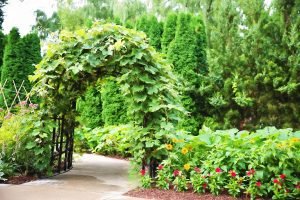Continuing my series of articles for 2019, Materials For A Purpose I am going to be discussing how best to choose the right materials for your desired purpose and how they best fit into the design of a space. I want to get you thinking about the options you have and how the right selection can give you a cohesive, timeless solution rather than a predictable, uninspiring result.
This month I want to investigate path products.
 Journey through a space is a classic reason for creating a path. There can be numerous reasons for needing a path from access to the garden shed, to traveling to the compost heap at the bottom of the garden. Some journeys are very functional while others are less obvious about their purpose. In a small garden a paved path from a sandstone patio along a rectilinear path of the same material to the garden shed makes perfect sense. The line of the path and the continuity of materials define the purpose. When a patio area finishes and there is more garden to engage with, but no obvious path, then the journey becomes less obvious. The shape of the flower beds can then be used to manipulate the journey. A well-positioned larger plant will encourage you to want to look beyond it and experience what is round the corner. The position of borders are helping to indicate the journey on the lawn and through the space. Perhaps the top of a pergola can be seen beyond the planting or the sound of water is pulling you along to find out. If the path is very obvious then the experience of working out the journey is quite different.
Journey through a space is a classic reason for creating a path. There can be numerous reasons for needing a path from access to the garden shed, to traveling to the compost heap at the bottom of the garden. Some journeys are very functional while others are less obvious about their purpose. In a small garden a paved path from a sandstone patio along a rectilinear path of the same material to the garden shed makes perfect sense. The line of the path and the continuity of materials define the purpose. When a patio area finishes and there is more garden to engage with, but no obvious path, then the journey becomes less obvious. The shape of the flower beds can then be used to manipulate the journey. A well-positioned larger plant will encourage you to want to look beyond it and experience what is round the corner. The position of borders are helping to indicate the journey on the lawn and through the space. Perhaps the top of a pergola can be seen beyond the planting or the sound of water is pulling you along to find out. If the path is very obvious then the experience of working out the journey is quite different.
Atmosphere can be created by the clever use of paths in a garden design. I recently designed a garden using red brick pavers that meandered around the edge of a lawn on one side and a deep border on the other. The path material not only tied in with the old property in style and colour, but the atmosphere of rustic and informal curves helped bring the design together. The journey under foot may have been firm but the feeling was gentle and relaxed. Had I designed a straight line from one entertaining patio to another at the top of the garden with sawn edged granite planks the effect would have created a very different atmosphere. It is important to consider the style you aspire to when designing a garden as the material selection can be used to develop the theme. Very contemporary material are in conflict with the design style of rural rustic charm. Whereas large square porcelain pieces laid to continue the outside-inside living style create a very contemporary look.
Anticipation is an important part of the experience of a garden space. The idea of creating different rooms in the garden has been around for years but the linking factor is always a path. Paths come in all different material shapes and sizes but how they are positioned in the space helps to give the sense of journey. Hard landscaping certainly has its place in the garden but a simple grass path cut through a wild flower meadow has a lovely charm about it especially if the end point is not obvious. I do like a focal point at the end of a path but trying to cultivate a feeling of experiencing the garden and allowing the spaces to reveal themselves is a concept I like to develop with clients.
Transition points using paths help mark movement from one space to the next. A change of material on the path helps to reinforce the change and can be gentle or abrupt depending on the reason for the transition. For example if you moved from a paved entertaining space toward a shady shrub walk you may choose to transition to bark pieces as a path material. Gentle transition can be achieved by gradually petering out a paving material through gravel or grass to becoming a stepping stone path that gently ends.














